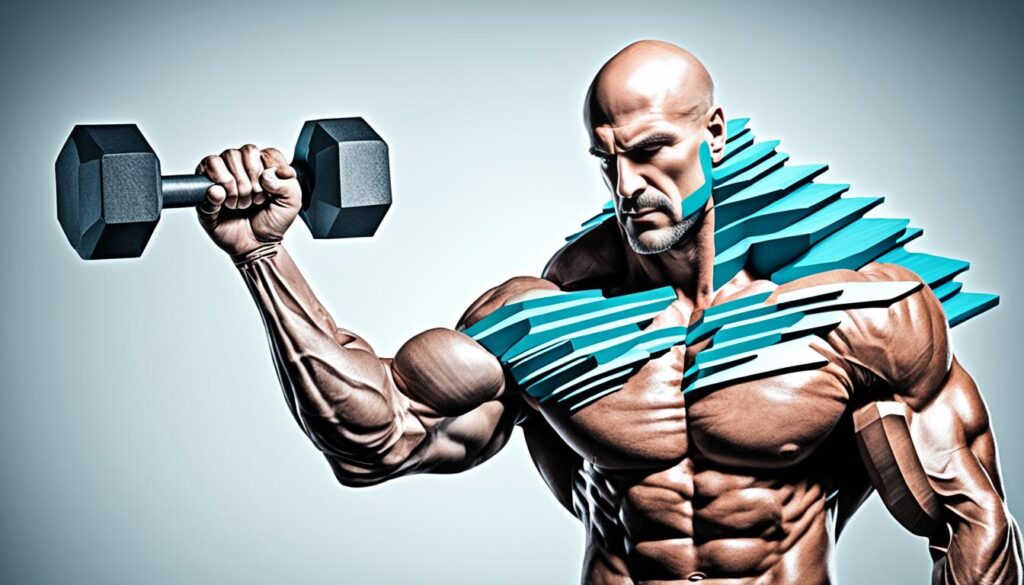Effective Dumbbell Workout For Biceps | Build Arms Fast

If you’re looking to build strong, sculpted arms, an effective dumbbell workout for your biceps is the way to go. In this comprehensive article, I’ll guide you through the essential elements of a dumbbell-focused bicep routine that can help you achieve your fitness goals quickly and efficiently. We’ll explore the basics of dumbbell bicep curls, dive into compound exercises for complete arm development, and discuss strategies to overcome plateaus and maximize your muscle growth.
Whether you’re a beginner or an experienced weightlifter, this dumbbell bicep workout will provide you with the tools and techniques to take your arm strength and definition to new heights. By the end of this article, you’ll have a clear understanding of how to effectively incorporate dumbbell exercises into your training regimen to build the arms you’ve always wanted.
Key Takeaways
- Dumbbell exercises are highly effective for targeting and developing the biceps muscles.
- Proper form and technique are crucial for maximizing the benefits of dumbbell bicep curls.
- Incorporating compound exercises into your routine can lead to more comprehensive arm development.
- Monitoring progress and making adjustments to your dumbbell workout can help you overcome plateaus and continue building muscle.
- Prioritizing nutrition and recovery strategies can support your muscle-building efforts.
Introduction to Dumbbell Bicep Workouts
When it comes to building strong, defined biceps, dumbbell exercises are a game-changer. Compared to barbells, dumbbells offer a host of benefits that make them an essential tool for dumbbell bicep workouts and bicep development. From greater range of motion to better muscle isolation, the versatility of dumbbells is unparalleled.
Why Dumbbells for Bicep Development
The unique advantage of dumbbells lies in their ability to address muscular imbalances. By working each arm independently, you can ensure that both biceps are developing at an equal pace, preventing any lopsided growth. Additionally, the increased range of motion afforded by dumbbells allows for deeper muscle contractions, leading to greater muscle activation and ultimately, stronger arms.
Setting Realistic Arm Goals
Before embarking on your dumbbell bicep workout journey, it’s important to set realistic goals. Factors such as your current fitness level, training experience, and overall body composition will all play a role in determining the rate of your bicep development and arm goals. Be patient, consistent, and focus on progressive overload to see the best results from your strength training efforts.
“Consistent, progressive dumbbell exercises are the key to building impressive biceps and achieving your muscle building goals.”
The Basics of Dumbbell Bicep Curls
As a fundamental exercise in any dumbbell bicep workout, mastering the proper technique for dumbbell bicep curls is crucial for building strong, defined arms. This classic exercise targets the biceps brachii, the large muscle group responsible for flexing the elbow and supinating the forearm.
To perform dumbbell bicep curls correctly, start by standing with your feet shoulder-width apart, knees slightly bent, and core engaged. Hold a dumbbell in each hand with an underhand grip, palms facing up. Keeping your upper arms stationary and elbows tucked close to your sides, slowly curl the weights up towards your shoulders, focusing on contracting your biceps. Pause briefly at the top of the movement, then slowly lower the weights back to the starting position.
- Maintain proper posture throughout the exercise, avoiding swinging or using momentum to lift the weights.
- Concentrate on keeping your wrists straight and avoiding any unnecessary wrist flexion or extension.
- Incorporate both unilateral (one arm at a time) and bilateral (both arms together) variations to target the biceps from different angles and promote balanced muscle development.
By mastering the fundamentals of dumbbell bicep curls, you’ll lay a solid foundation for building impressive arm strength and muscle definition. Remember to adjust the weight, sets, and reps based on your fitness level and goals to continually challenge your biceps and drive progress in your arm exercises and strength training regimen.
| Exercise | Muscles Targeted | Benefits |
|---|---|---|
| Dumbbell Bicep Curls | Biceps Brachii | Builds muscle building and strength training in the biceps, promotes better elbow flexion and forearm supination. |
“The dumbbell bicep curl is a classic exercise that should be the foundation of any dumbbell bicep curls workout routine. Mastering the proper form and technique is key to maximizing the benefits and avoiding injury.”
Dumbbell Workout For Biceps
Building impressive biceps doesn’t require a complex workout routine. In fact, a well-designed dumbbell workout can be incredibly effective for sculpting powerful arms. By focusing on proper form and incorporating strategic variations, you can maximize the impact of your dumbbell bicep exercises and see real results.
Proper Form and Technique
Proper form is essential when performing dumbbell bicep curls to target the muscles effectively and avoid injury. Start by standing with your feet shoulder-width apart, core engaged, and elbows tucked close to your sides. Slowly curl the weights up towards your shoulders, keeping your upper arms stationary. Pause briefly at the top of the movement, then lower the weights back to the starting position in a controlled motion.
Variations and Intensity Boosters
- Hammer curls: Rotate your palms so they face your body, keeping your elbows fixed in place as you curl the weights up.
- Reverse curls: Grip the weights with your palms facing down to target the brachioradialis muscles on the front of your forearms.
- Concentration curls: Sit on a bench, resting one elbow on the inside of your thigh to isolate and challenge the bicep.
- Alternating curls: Curl one arm at a time, allowing you to focus on each bicep individually and correct any imbalances.
To further challenge your biceps and drive muscle growth, incorporate techniques like drop sets, supersets, and rest-pause training into your dumbbell bicep routine. These intensity boosters will push your muscles to the limit and stimulate new levels of strength and development.
By mastering the fundamentals of proper form and exploring a variety of dumbbell bicep exercises, you can build a comprehensive workout that will help you achieve your arm-building goals. Remember to stay consistent and gradually increase the weight and intensity to continuously challenge your muscles and see ongoing progress.
Discover more effective dumbbell bicep exercisesto incorporate into your training routine.
Compound Exercises for Complete Arm Development
While isolation exercises like dumbbell bicep curls are essential for targeting the arms, incorporating compound exercises into your strength training routine can provide a more well-rounded approach to arm development. Compound movements engage multiple muscle groups simultaneously, leading to increased muscle activation, improved functional strength, and a more balanced physique.
One of the primary benefits of compound exercises is their ability to stimulate growth across the entire arm, including the biceps, triceps, and forearms. By working multiple joints and muscle groups at once, these exercises challenge your body to coordinate and stabilize, resulting in greater overall arm development.
Here are some effective compound exercises that can take your arm workouts to the next level:
- Barbell Rows – This classic compound exercise targets the back, biceps, and grip strength, contributing to a stronger, more defined arm appearance.
- Pull-ups and Chin-ups – These bodyweight exercises engage the biceps, back, and core, building impressive arm and upper body strength.
- Overhead Press – This compound move works the shoulders, triceps, and core, providing a comprehensive upper body workout.
- Deadlifts – While primarily a lower body exercise, deadlifts also involve the arms, back, and grip, resulting in overall arm and muscle development.
By incorporating these compound exercises into your strength training program, you can achieve a well-rounded, sculpted arm physique and support your overall muscle-building goals. Remember to focus on proper form and gradually increase the intensity to maximize the benefits of these compound movements.
| Exercise | Primary Muscle Groups Targeted | Benefits for Arm Development |
|---|---|---|
| Barbell Rows | Back, Biceps, Grip Strength | Stimulates growth in the arms, especially the biceps, and improves overall pulling strength. |
| Pull-ups and Chin-ups | Biceps, Back, Core | Builds impressive upper body and arm strength, particularly in the biceps and pulling muscles. |
| Overhead Press | Shoulders, Triceps, Core | Engages the arms, shoulders, and core, leading to a balanced, muscular upper body. |
| Deadlifts | Legs, Back, Grip Strength | Involves the arms, back, and grip, contributing to overall arm and muscle development. |

“Compound exercises should be the foundation of any strength training program, as they allow you to lift heavier weights and stimulate more muscle growth across multiple muscle groups.”
Incorporating Bicep Workouts into Your Routine
Effectively incorporating your dumbbell bicep workouts into your overall fitness routine is key to achieving your arm-building goals. By strategically balancing push and pull movements, you can ensure that your bicep training is optimized for maximum results.
Balancing Push and Pull Movements
The key to a well-rounded workout routine is to incorporate both push and pull movements. Push exercises like overhead presses and bench presses primarily work the muscles on the front of your body, while pull exercises like rows and pullups focus on the muscles on the back of your body By balancing these opposing movements, you can achieve a harmonious development of your upper body, including your biceps.
To ensure that your bicep workouts are properly integrated, consider structuring your routine like this:
- Start with a push exercise, such as a dumbbell shoulder press.
- Follow it with a pull exercise that targets your biceps, like seated dumbbell curls.
- Alternate between push and pull movements throughout your workout, ensuring that your biceps are trained alongside your other major muscle groups.
This approach not only ensures a balanced workout, but it also helps to prevent muscle imbalances and maximize the effectiveness of your incorporating bicep workouts.
“Incorporating bicep workouts into your routine is essential for building well-rounded, strong arms. By balancing push and pull movements, you’ll see greater gains in muscle building and strength training.”
Remember, consistency is key when it comes to workout routine and incorporating bicep workouts. By making dumbbell bicep curls a regular part of your fitness regimen, you’ll be well on your way to sculpting the arms you’ve always wanted.
Nutrition for Muscle Growth and Recovery
Proper nutrition is the cornerstone of any successful muscle-building program. Whether your goal is to build bigger biceps or achieve an overall muscular physique, what you eat plays a crucial role in fueling your muscle growth and supporting your body’s recovery after strength training sessions.
Protein is essential for repairing and rebuilding muscle fibers, so be sure to consume high-quality protein sources like eggs, ricotta, salmon, cottage cheese, and around your workouts. Aim for a ratio of 1.6-2.2 grams of protein per kilogram of body weight, depending on the intensity of your strength training.
Carbohydrates are equally important, as they replenish depleted glycogen stores and provide the energy your muscles need to power through your muscle building sessions. Consider incorporating complex carbs like sweet potatoes, whole-grain bread, and quinoa into your post-workout meals.
Healthy fats, such as those found in salmon, avocado, and nuts, play a vital role in hormone production, joint health, and overall recovery. Aim for a balanced intake of these essential nutrients to support your fitness goals.
Proper hydration is also crucial for muscle growth and recovery. Be sure to stay hydrated throughout the day and consider incorporating tart cherry juice or watermelon into your post-workout routine to help reduce inflammation and speed up the recovery process.
Remember, a well-rounded, nutrient-dense diet is the foundation for building the arms and physique you desire. By focusing on high-quality, whole-food sources of protein, carbs, and healthy fats, you’ll be well on your way to maximizing your muscle growth and recovery from your dumbbell bicep workouts.
Overcoming Plateaus in Bicep Development
Building impressive biceps is not without its challenges. Inevitably, you’ll encounter plateaus where your progress seems to stall. But fear not, there are effective strategies to break through these frustrating roadblocks and kickstart your bicep development once again.
One of the primary reasons for plateaus is that your muscles have become accustomed to your current workout routine. To overcome this, it’s essential to mix up your dumbbell exercises and incorporate new variations. This could involve trying different grip positions, altering the tempo of your lifts, or experimenting with distinct bicep-targeting movements.
Additionally, adjusting the volume and intensity of your workouts can help stimulate further growth. Try increasing the number of sets or reps per exercise, or challenge yourself with heavier weights. Just be mindful not to overdo it, as overtraining can lead to injury and further setbacks.
Another effective strategy is to focus on compound exercises that engage multiple muscle groups, such as rows and chin-ups. These exercises not only work the biceps but also stimulate overall arm and upper body development, helping to break through bicep plateaus.
Finally, don’t underestimate the importance of proper nutrition and recovery. Ensuring you consume enough protein, carbohydrates, and healthy fats can provide the fuel your muscles need to grow, while adequate rest and sleep allow your body to repair and rebuild.
By implementing these strategies, you can overcome the frustration of bicep plateaus and continue making progress towards your overcoming plateaus, bicep development, strength training, muscle building goals. Stay persistent, experiment with new approaches, and be patient – your biceps will thank you in the long run.
“The path to muscular success is paved with small, consistent steps forward, not giant leaps. Embrace the process, and your biceps will grow.”
| Strategies to Overcome Bicep Plateaus | Benefits |
|---|---|
| Incorporate New Dumbbell Exercises | Prevents muscle adaptation, stimulates growth |
| Adjust Volume and Intensity | Challenges muscles to adapt and grow |
| Focus on Compound Exercises | Engages multiple muscle groups for complete arm development |
| Optimize Nutrition and Recovery | Provides the fuel and resources for muscle growth and repair |

Common Mistakes to Avoid
Achieving optimal results from your dumbbell bicep workouts requires vigilance in avoiding common pitfalls. Two of the most significant hurdles to overcome are improper form and overtraining.
Improper Form
Maintaining proper form during bicep curls is essential for maximizing muscle growth and preventing injury. Improper technique, such as swinging the weights or arching the back, can reduce the effectiveness of the exercise and put unnecessary stress on the joints. To ensure proper form:
- Keep your elbows stationary and close to your sides throughout the movement.
- Avoid using momentum to swing the weights up; focus on controlled, deliberate contractions.
- Maintain a neutral spine and avoid excessive arching of the back.
- Fully extend your arms at the bottom of the movement, then concentrate on the contraction as you curl the weights up.
Overtraining
Another common mistake is overtraining the biceps, leading to muscle fatigue, decreased strength, and even the risk of injury. Overtraining can undermine your strength training efforts and hinder muscle building. To avoid this:
- Allow for adequate rest and recovery between bicep-focused workouts.
- Limit your bicep exercises to 2-3 times per week, with at least 48 hours of rest between sessions.
- Listen to your body and adjust your training volume and intensity accordingly.
By avoiding these common mistakes, you can ensure that your dumbbell bicep workouts are productive, safe, and conducive to building the strong, defined arms you desire.
Tracking Progress and Adjusting Your Dumbbell Workout For Biceps
Consistent progress tracking and workout adjustments are crucial for achieving your arm and muscle building goals. By closely monitoring your dumbbell bicep training, you can make informed decisions to challenge your muscles and drive continued growth.
To track your progress, focus on key metrics such as:
- Rep counts: Aim to gradually increase the number of reps you can complete with a given weight.
- Weight increments: Slowly increase the dumbbell weight as you get stronger.
- Arm circumference: Measure your bicep size to quantify your muscle building progress.
Adjusting your dumbbell workout for biceps is essential to avoid plateaus and continue challenging your muscles. Consider:
- Varying your rep ranges (e.g., 8-12 reps one week, 15-20 reps the next)
- Trying new bicep curl variations like hammer curls or concentration curls
- Incorporating compound exercises like rows or pull-ups to work your entire arm
By tracking progress and adjusting your dumbbell workout for biceps, you’ll be able to maximize your muscle building and strength training efforts. Stay consistent, adapt your routine, and watch your arms grow!
“Continuous improvement is better than delayed perfection.” – Mark Twain
Conclusion
In this comprehensive guide, we’ve explored the fundamentals of an effective dumbbell workout for biceps, arming you with the knowledge and techniques to build strong, sculpted arms. By mastering the essentials of dumbbell bicep curls, incorporating compound exercises, and optimizing your nutrition and recovery, you’re well on your way to achieving your arm-building goals.
Remember, the journey to muscle growth and development is a continual process of dedication and consistency. Embrace the challenge, track your progress, and make adjustments as needed to ensure continued success. With the right approach, you’ll witness your biceps grow stronger and more defined with each passing workout.
Whether your aim is to enhance your overall strength training regimen or specifically target and develop your arm muscles, this dumbbell workout for biceps provides a solid foundation for building the physique you desire. Commit to the process, stay focused, and watch your biceps transform into the sculpted, powerful assets you’ve always envisioned.
FAQ
What are the benefits of using dumbbells for bicep development?
Compared to barbells, dumbbells allow for a greater range of motion, better isolation of the biceps, and the ability to address muscular imbalances. Dumbbell exercises are a fantastic way to target and build your biceps.
How can I set realistic arm-building goals?
When setting arm-building goals, it’s important to be realistic and consider factors like your current fitness level, training experience, and genetics. Start with achievable goals and gradually increase the difficulty as you progress.
What is the proper form for dumbbell bicep curls?
Proper form for dumbbell bicep curls includes keeping your elbows stationary, maintaining control throughout the movement, and avoiding swinging or using momentum to lift the weights. This ensures maximum bicep activation and reduces the risk of injury.
What are some variations and intensity boosters for dumbbell bicep exercises?
Variations like hammer curls, incline curls, and concentration curls can target your biceps from different angles and help prevent plateaus. Intensity boosters such as drop sets, super sets, and forced reps can also help challenge your muscles and drive further growth.
How can compound exercises benefit my arm development?
While isolation exercises like dumbbell bicep curls are essential, incorporating compound exercises that involve multiple muscle groups, such as pull-ups, rows, and chin-ups, can provide a more well-rounded approach to arm development and promote overall strength and muscle growth.
How should I balance push and pull movements in my workout routine?
Balancing push and pull movements is crucial for achieving a symmetrical and well-developed upper body. Aim for a roughly equal number of push and pull exercises in your routine to ensure balanced muscle development and prevent imbalances.
What role does nutrition play in muscle growth and recovery?
Proper nutrition is essential for fueling muscle growth and supporting recovery after your dumbbell bicep workouts. Focus on consuming adequate protein, complex carbohydrates, and healthy fats, while staying hydrated to optimize your results.
How can I overcome plateaus in my bicep development?
To overcome plateaus, consider adjusting your training volume, incorporating new exercises, and making strategic changes to your workout routine. Regularly reassessing your progress and making informed adjustments can help you continue to challenge your muscles and drive further growth.
What are some common mistakes to avoid when doing dumbbell bicep workouts?
Common mistakes to avoid include using improper form, which can lead to injury, and overtraining, which can hinder recovery and progress. Maintaining proper form and being mindful of your body’s signals are crucial for safe and effective dumbbell bicep workouts.
How can I track my progress and adjust my dumbbell workout for biceps?
Consistently tracking your progress, such as monitoring rep counts, weight increments, and measuring arm circumference, is essential for continued growth and development. Make adjustments to your workout routine based on your progress to ensure you continue to challenge your muscles and achieve your fitness goals.






